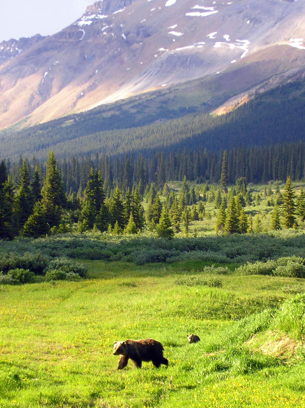Module 8
1. Module 8
1.24. Lesson 6
Module 8—Populations, Individuals, and Gene Pools
Lesson 6—Role of Defence
 Get Focused
Get Focused

© Paul Zizka/2930492/fotolia
If you were to spend a weekend hiking through the backcountry of Banff National Park, you’d probably see pika, mountain goat, elk, and perhaps a grizzly bear as it makes its way across the alpine meadow. Sometimes it is difficult to remember that each species you see is a winner—a species that has out-competed all others that have attempted to share its niche. What defensive traits have made these species winners in their environment?
niche: a position or role taken by an organism within its community

© Baudot/shutterstock
The grizzly bear’s structural defences are easy to spot: its massive size, its powerful claws, and the presence of huge sharp teeth, are all obvious. Behavioural defences, like standing up on hind legs, bristling of hair to make it appear larger, baring of teeth, growling, laying back of ears, and mock-charging, all indicate danger to would-be competitors or predators. What other kinds of defences do organisms use to protect themselves (and their alleles) from elimination by competition or predation?
In this lesson the following focusing question will be examined:
- What are the defence mechanisms within predation and competition?
 Module 8: Lesson 6 Assignment
Module 8: Lesson 6 Assignment
Download a copy of the Module 8: Lesson 6 Assignment to your computer now. You will receive further instructions on how to complete this assignment later in the lesson.
In addition to your lesson work, any summary notes, diagrams, charts, or tables should be stored in the course folder for your teacher’s feedback and study as you prepare for exams.
The other questions and activities in this lesson are not marked by the teacher; however, you should still attempt all of the work offered here. These questions are designed to help you review important information and build key concepts that may be applied in future lessons.
After a discussion with your teacher, you must decide what to do with the questions that are not part of your assignment. For example, you may decide to submit to your teacher the responses to “Try This” questions that are not marked. Regardless of what you submit, you should record the answers to all the questions in this lesson and place those answers in your course folder.
Remember, you also have the option of trying additional questions from the textbook for further practice. Consult with your teacher for the answers to these questions. The Key will also provide you with many Diploma Exam-style multiple-choice, numerical-response, and written-response questions that will be an excellent review of the module. Practising your responses to these types of questions is good preparation for the Diploma Exam.